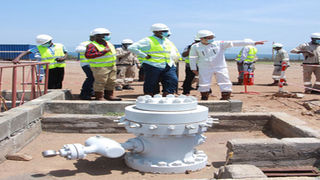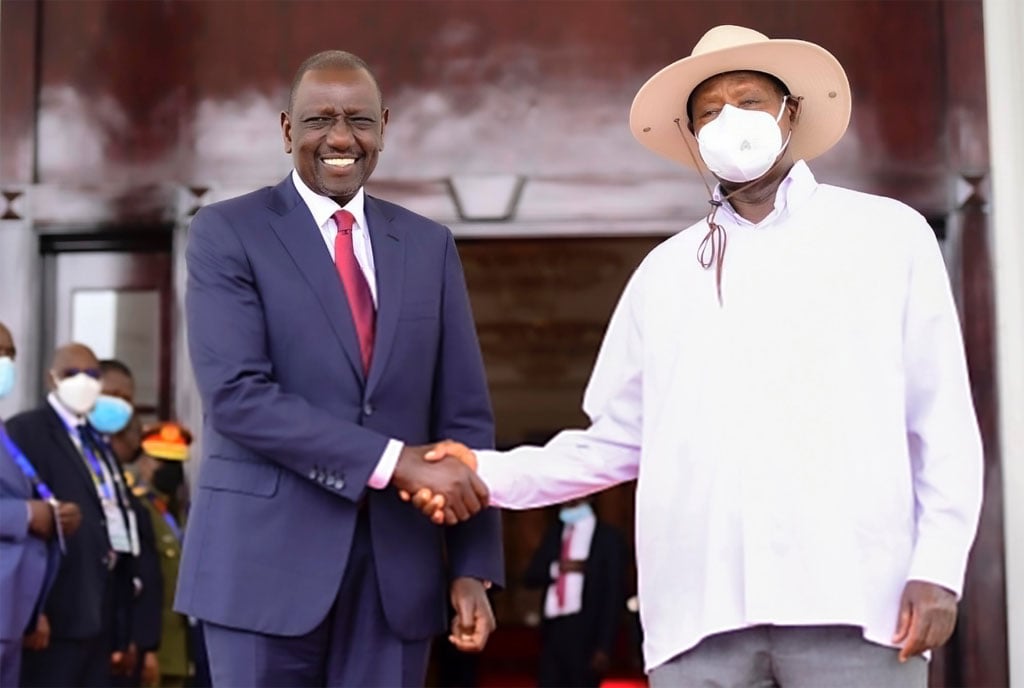
Ramathan Ggoobi, the Finance ministry permanent secretary (centre) being shown one of the oil well in the KingFisher oilfield area during a tour of the oil facilities in the Albertine Graben. PHOTO/ FILE
|Prosper
Prime
2024: A ‘do or die’ for commercial oil production
What you need to know:
The government is hell-bent on the oil project timelines, saying the country’s oil commercial production deadline remains as set – in the year 2025, barely 12 months away from now.
Anything and everything that needs to be done for the country’s oil to see light of the day must be exhausted within this year or else the set 2025 commercial production timeline, already facing backlash from the anti-fossil fuel activists, risk being relegated to the periphery as calls to transition to cleaner renewable fuels gains momentum.
Even as the clock ticks on the oil project, Prosper Magazine has since established that government is hell-bent on the oil project timelines, saying the country’s oil commercial production deadline remains as set – in the year 2025, barely 12 months away from now.
In his speech delivered by Vice President Jessica Alupo at the East Africa Investment Forum and Trade Exhibition – one of the flagship event that run alongside NAM and G77 Summit held last week in Kampala, President Museveni noted that production timelines for the country’s oil firmly remains is in 2025.
Earlier in the same event, the Minister of Energy, Ms Ruth Nankabirwa, said: “let the World know that Uganda is not going to abandon her petroleum resources.”
For starters, CNOOC and TotalEnergies co-own all of Uganda’s existing oilfields alongside the state-run Uganda National Oil Company - mandated to hold 15 per cent participating interest as the Government’s Nominee in the Petroleum Production Licenses awarded for discovered oil and gas fields.
At peak, according to a Ministry of Energy report, the country projects to produce about 230,000 barrels of crude oil per day.
The country’s crude reserves are estimated at 6.5 billion barrels, of which 1.4 billion barrels are recoverable.
At the moment the country is at the zenith of what oil and gas sector analysts consider the most lucrative phase for the private sector and the citizens to partake or lose out. This became evident after signing final investment decision (FID) In February 2022, finalising terms of a $10b drilling and pipeline project.

An oil rig in Western Uganda. PHOTO/FILE
Currently there are nine production licenses, covering 13 oil and gas fields in which UNOC manages the participating interest of the State. These fields are planned to be developed through the Tilenga and Kingfisher Projects and commercialised through an in-country refinery and a crude export pipeline.
Outlook
The government and the international oil companies have invested more than $4 billion in Uganda’s oil and gas industry to date, according to Uganda Oil and Gas Outlook 2024.
Going by the most recent oil and gas sector analysis, this year (2024), sets out to be one of reckoning for Uganda’s oil and gas industry as industry players look to conclude most of the major investment decisions in 2024 before the political temperature heats up in 2025 ahead of the early 2026 general elections.
The shareholders of the major upstream oil and gas projects in the country, according to the report, will have to deal with “a tight credit market in 2024 as they try to nail down financing for their different projects.”
Credit markets have faced a lot of pressure and criticism in recent years over their financing of fossil fuel projects, thanks to anti-fossil fuel activists and environmental defenders, implying that the government will have to find alternative much-needed capital for UNOC - the finance arm of the state in the oil and gas industry, to undertake its mandate.
Until a solution to this financing issue is resolved, “we see a delay across the board within Uganda’s upstream oil industry,” reads part of the analysis.
Although all the four oil rigs are in Uganda, work programmes in the Tilenga and Kingfisher fields, according to findings of the report, are moving at a slower pace. To pick up the pace, negotiations for the project entire debts should be completed.
Start oil production soonest
When contacted, the director of research and policy at Bank of Uganda, Mr Adam Mugume noted that global trade and investment would continue to be stifled by conflicts in Ukraine and the Middle East, saying this has implications on what goes on in Uganda.

Camping facilities for oil workers at the KingFisher Area operated by CNOOC in Kikuube district. PHOTO/FILE
He said: “With external financing stifled by global challenges, Uganda needs to fast-track the oil production and therefore efforts to start getting oil revenues by 2025 are really calming. However, I would be hesitant to say it do or die scenario.”
According to Dr Mugume, its enormous infrastructure is required to start exporting oil and this he said involved external financing by way of borrowing. Already some of the external loans associated with the oil development are being serviced with the current global interest rates which is at elevated levels.
For that, “Uganda needs to start oil production soonest to reduce the external debt servicing burden,” notes Dr Mugume, before adding, “the current heightened geopolitical risks point to the need to have our own secure oil since the oil reserves are economical for extraction.
He continued: “The world is starting to demand low carbon emissions, and this could eventually impact the oil prices resulting in less attraction in exploration and extraction.”
Importantly perhaps, external debt servicing burden has increased, requiring on average about $1.2 billion per financial year 2023/24-2024/25. Moreover, the disruption to key shipping routes caused by attacks on vessels in the Red Sea has increased the likelihood of global inflation requiring maintaining of higher interest rates in the world’s biggest economies.
This, according to Dr Mugume makes new and old external commercial loans more expensive as most external commercial loans are to a great extent at variables interest rates. Therefore, exporting oil, when the oil prices are still attractive will greatly ease the debt servicing burden.
We are on course
Even with a clock ticking, there are those who sees no reason to raise alarm as everything is on course.
“In my opinion, adequate preparation are ongoing to facilitate first oil in 2025. However, it’s not a do-or-die timeline,” the head of the macroeconomics department at the Economic Policy Research Centre (EPRC), Mr Corti Paul Lakuma, said when contacted.
Mr Lakuma, also EPRC Senior Research Fellow, further noted: “Though I would like to see first oil in 2025, other fundamental have to be in place to facilitate such. These are not limited to essential infrastructure, but also favourable market fundamentals such as an attractive international price.”
In an interview, the chief legal and corporate affairs officer, Uganda National Oil Company (UNOC), Mr Peter Muliisa reaffirms that nothing is out of hand and that all is well save for slight hitches which he describes as “small manageable situations”.
“We are on course. We are now concluding land acquisitions for the pipeline which we should have finished last year although the remaining percentage is too small to derail the schedule,” he told Prosper Magazine last week.
He noted that government has done great so far in terms of financing the pipeline, developing required roads, airports and other infrastructure.
According to Ms Nankabirwa, about 95 per cent of payment to the affected persons as a result of the oil projected have been completed and 100 per cent of the pipeline work is progressing smoothly.
Game changer
According to Uganda Oil and Gas Outlook 2024 report, the East African Crude Oil Pipeline project remains the biggest game changer for Uganda’s oil and gas set-up.
The progress according to Ms Nankabirwa is going on smoothly, although the reports indicates that much of the attention in the first half of 2024 will be on when the shareholders can finally close financing for the project.
“Recently, the first batch of pipes – stretching 100km – arrived in Dar es Salaam, offering hope that construction works were set to start. However, the slow progress in closing financing for the crude oil pipeline project, and the increased pressure from environmentalists, has thrown further uncertainty over the project, and adjusted the risk of a delayed first oil target for Uganda upwards,” reads the report in part.





